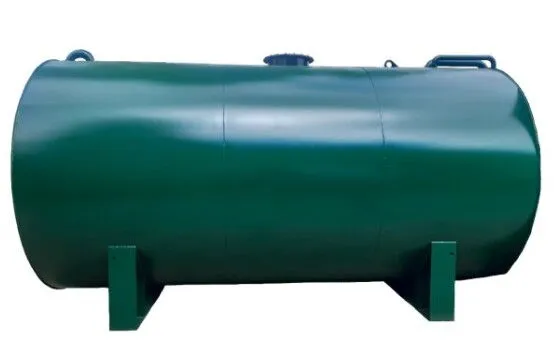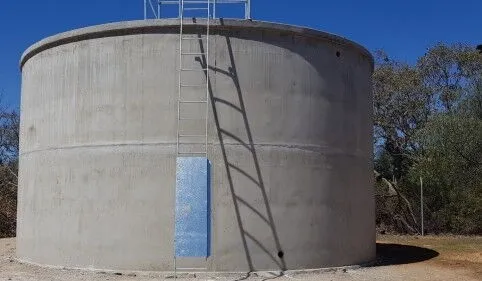Oil tanks are essential equipment for storing oil products, primarily serving to maintain the quality of the oil and prevent leakage and contamination. Based on the material, oil tanks can be divided into metal and non-metal oil tanks. Each type of tank differs in strength, construction difficulty, durability, sealing performance, cost, and suitability for various environments. This article provides a detailed comparison of these two types of oil tanks to help understand their respective advantages and disadvantages.
Materials and Strength
Metal oil tanks are typically made from steel plates such as carbon steel, stainless steel, and other alloys, which are welded together. The materials are robust and can withstand high pressures. This makes metal oil tanks particularly suitable for storing high-pressure oil products. For example, spherical steel oil tanks can withstand operating pressures ranging from 0.45 to 3 MPa and are commonly used to store liquefied petroleum gas and other high-pressure oils. The toughness of metal materials also allows them to resist a certain degree of external impact without easy damage.

Non-metal oil tanks are generally constructed from brick, stone, or reinforced concrete. While these materials have high rigidity, they lack the toughness and impact resistance of metals, making them prone to cracking or damage when subjected to significant external forces. Additionally, non-metal tanks have limited pressure-bearing capacity, making them suitable primarily for storing oils under normal or low pressure.

Construction Process and Flexibility
The construction technology for metal oil tanks is well-established, with common designs including vertical cylindrical, horizontal cylindrical, and spherical shapes. Welding is the primary method used during construction, which allows for fast assembly and flexible adjustments to meet site-specific requirements, such as capacity and shape. Techniques like inverted assembly are often used to reduce the amount of high-altitude work, improving both efficiency and safety.
The construction of non-metal oil tanks is more complex and time-consuming. For example, reinforced concrete oil tanks require the assembly of formwork, the binding of rebar, and the pouring of concrete. Each step needs precise control and skilled workmanship. As a result, the construction period for non-metal oil tanks is longer, and once completed, any modifications or renovations are difficult, offering limited flexibility.
Sealing and Oil Protection
Metal oil tanks offer excellent sealing properties. When welding is done with precision, and seals at the tank and associated components (such as valves and pipe connections) are properly maintained, they effectively prevent oil leakage or evaporation. This helps preserve oil quality and avoid environmental contamination.
Non-metal oil tanks also incorporate sealing measures during construction, but due to the inherent properties of the materials and the potential for tiny gaps during the construction process, the sealing performance is typically not as good as that of metal tanks. Therefore, non-metal tanks carry a certain risk of leakage, which could lead to oil loss or environmental pollution.
Corrosion Resistance and Service Life
Metal oil tanks are susceptible to environmental factors, especially in humid or corrosive conditions where the metal may rust or corrode, thus affecting their service life. However, with proper anti-corrosion measures, such as coating with anti-corrosion paint, and regular maintenance, metal tanks can last for a long time.
Non-metal oil tanks are generally more resistant to certain environmental factors, especially reinforced concrete tanks, which perform better in terms of humidity and climate changes. However, prolonged exposure to corrosive substances like acids and alkalis can still cause internal damage, reducing their service life.
Cost and Economics
The initial construction cost of metal oil tanks is relatively high, especially when using high-quality metals like stainless steel, which increases the price. However, due to their faster construction speed, the overall construction period is shorter, making them ideal for sites with higher requirements for oil quality and storage safety, where frequent oil turnover is necessary. Over the long term, metal tanks have lower maintenance costs, providing a better overall value.
Non-metal oil tanks have lower material costs, but because their construction is more complex and time-consuming, the total cost may not be significantly lower than that of metal tanks. Moreover, the higher maintenance costs, especially in case of leaks or damage, and the difficulty of repairs make non-metal tanks less economically advantageous in the long run. Therefore, while the initial investment is lower, the total cost over time may not be more economical.
Suitable Applications
Metal oil tanks are suitable for a wide range of oil storage needs. Whether for volatile oils like gasoline and diesel, or heavier oils like crude oil and liquefied petroleum gas, metal oil tanks can meet the requirements. They are commonly used in refineries, oil depots, and gas stations due to their versatility.
Non-metal oil tanks are best used in environments where pressure requirements are lower, storage volume is larger, and the storage conditions are more fixed. They are typically used in underground or semi-underground oil depots, where large-scale storage is needed. In such cases, non-metal oil tanks perform well, provided that the foundational construction and sealing measures are properly executed.
Shape and Design Flexibility
Metal oil tanks offer a variety of design options, such as vertical cylindrical, horizontal cylindrical, and spherical shapes. The internal structure is regular, making it easier to install various accessories such as floating roofs, gauging devices, and breathing valves, facilitating oil measurement, receiving, and storage management.
Non-metal oil tanks generally have fixed geometric shapes, and their internal structure is constrained by the materials used, offering less flexibility than metal tanks. Sometimes, special designs and constructions are required to install additional equipment, which can adapt to different storage needs.
Conclusion
Both metal and non-metal oil tanks have their respective strengths and weaknesses, making them suitable for different oil storage needs. Metal oil tanks are strong, durable, offer excellent sealing, and are suitable for high-pressure and volatile oil storage. They are constructed quickly, with simple maintenance, making them ideal for locations with high safety and efficiency requirements. Although the initial investment is higher, they provide better long-term value. Non-metal oil tanks, on the other hand, are cost-effective in terms of materials and suitable for low-pressure, large-volume storage, particularly in underground or semi-underground oil depots. However, their construction complexity, longer timeline, and higher maintenance costs mean that their long-term costs may not be more advantageous than those of metal oil tanks. The choice of which type to use should be based on factors such as the type of oil being stored, the operating environment, and budget.

 English
English Español
Español русский
русский